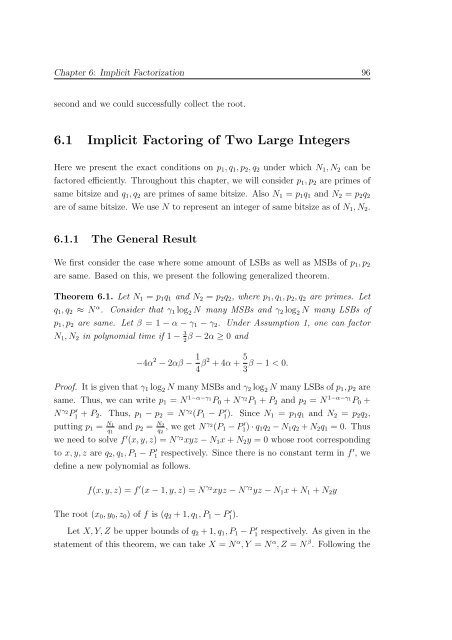Cryptanalysis of RSA Factorization - Library(ISI Kolkata) - Indian ...
Cryptanalysis of RSA Factorization - Library(ISI Kolkata) - Indian ...
Cryptanalysis of RSA Factorization - Library(ISI Kolkata) - Indian ...
You also want an ePaper? Increase the reach of your titles
YUMPU automatically turns print PDFs into web optimized ePapers that Google loves.
Chapter 6: Implicit <strong>Factorization</strong> 96<br />
second and we could successfully collect the root.<br />
6.1 Implicit Factoring <strong>of</strong> Two Large Integers<br />
Here we present the exact conditions on p 1 ,q 1 ,p 2 ,q 2 under which N 1 ,N 2 can be<br />
factored efficiently. Throughout this chapter, we will consider p 1 ,p 2 are primes <strong>of</strong><br />
same bitsize and q 1 ,q 2 are primes <strong>of</strong> same bitsize. Also N 1 = p 1 q 1 and N 2 = p 2 q 2<br />
are <strong>of</strong> same bitsize. We use N to represent an integer <strong>of</strong> same bitsize as <strong>of</strong> N 1 ,N 2 .<br />
6.1.1 The General Result<br />
We first consider the case where some amount <strong>of</strong> LSBs as well as MSBs <strong>of</strong> p 1 ,p 2<br />
are same. Based on this, we present the following generalized theorem.<br />
Theorem 6.1. Let N 1 = p 1 q 1 and N 2 = p 2 q 2 , where p 1 ,q 1 ,p 2 ,q 2 are primes. Let<br />
q 1 ,q 2 ≈ N α . Consider that γ 1 log 2 N many MSBs and γ 2 log 2 N many LSBs <strong>of</strong><br />
p 1 ,p 2 are same. Let β = 1 − α − γ 1 − γ 2 . Under Assumption 1, one can factor<br />
N 1 ,N 2 in polynomial time if 1− 3 β −2α ≥ 0 and<br />
2<br />
−4α 2 −2αβ − 1 4 β2 +4α+ 5 β −1 < 0.<br />
3<br />
Pro<strong>of</strong>. It is given that γ 1 log 2 N many MSBs and γ 2 log 2 N many LSBs <strong>of</strong> p 1 ,p 2 are<br />
same. Thus, we can write p 1 = N 1−α−γ 1<br />
P 0 +N γ 2<br />
P 1 +P 2 and p 2 = N 1−α−γ 1<br />
P 0 +<br />
N γ 2<br />
P ′ 1 + P 2 . Thus, p 1 − p 2 = N γ 2<br />
(P 1 − P ′ 1). Since N 1 = p 1 q 1 and N 2 = p 2 q 2 ,<br />
putting p 1 = N 1<br />
q 1<br />
and p 2 = N 2<br />
q 2<br />
, we get N γ 2<br />
(P 1 −P ′ 1)·q 1 q 2 −N 1 q 2 +N 2 q 1 = 0. Thus<br />
we need to solve f ′ (x,y,z) = N γ 2<br />
xyz −N 1 x+N 2 y = 0 whose root corresponding<br />
to x,y,z are q 2 ,q 1 ,P 1 −P ′ 1 respectively. Since there is no constant term in f ′ , we<br />
define a new polynomial as follows.<br />
f(x,y,z) = f ′ (x−1,y,z) = N γ 2<br />
xyz −N γ 2<br />
yz −N 1 x+N 1 +N 2 y<br />
The root (x 0 ,y 0 ,z 0 ) <strong>of</strong> f is (q 2 +1,q 1 ,P 1 −P ′ 1).<br />
Let X,Y,Z be upper bounds <strong>of</strong> q 2 +1,q 1 ,P 1 −P ′ 1 respectively. As given in the<br />
statement <strong>of</strong> this theorem, we can take X = N α ,Y = N α ,Z = N β . Following the
















